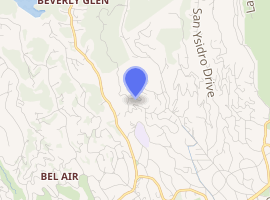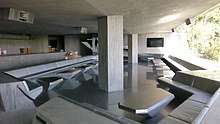Sheats–Goldstein Residence
The Sheats–Goldstein Residence is a home designed and built between 1961 and 1963 by American architect John Lautner in the Beverly Crest neighborhood of Los Angeles, California, a short distance from the Beverly Hills border. The building was conceived from the inside out and built into the sandstone ledge of the hillside; a cave-like dwelling that opens to embrace nature and view.[1] The house is an example of American Organic Architecture that derives its form as an extension of the natural environment and of the individual for whom it was built. Typical of Lautner's work, the project was approached from an idea and a unique structure was derived that solved the challenges of the site.
| Sheats Goldstein Residence | |
|---|---|

| |
| General information | |
| Type | House |
| Architectural style | Organic architecture |
| Location | Angelo View Drive, Los Angeles, California |
| Coordinates | 34.0936°N 118.435°W |
| Construction started | 1963 |
| Technical details | |
| Structural system | Poured-in-place concrete |
| Floor area | 4,500 sq ft (420 m2) |
| Design and construction | |
| Architect | John Lautner |
History

The home was originally built for Helen and Paul Sheats and their three children. Helen, an artist, and Paul, a university professor, had previously commissioned Lautner for the 1948–1949 Sheats Apartments project located in Westwood adjacent to the University of California, Los Angeles.
There were two subsequent owners before a businessman, James Goldstein, purchased the residence in 1972, in a state of some disrepair. No walls existed in the living room, and a device meant to heat the house often did not work well.[2] Goldstein commissioned John Lautner to work on the transformation of the house; a series of remodelings that would encompass the entire house over a period of more than two decades. Goldstein worked with Lautner until the architect's death in 1994 on what they called "perfecting" the house.[3]
The Sheats–Goldstein Residence is one of the best known examples of John Lautner's work; he designed not only the house, but the interiors, windows, lighting, rugs, furniture, and operable features. The house is extensively detailed, and the range of the architect's work is visible through the different stages of the re-mastering. All of the furnishings enhance the house and are completely related so that the aesthetic of the forms is a function of the whole.
The original construction of the house is poured-in-place concrete, steel, and wood. The home was built with five bedrooms, four and a half baths, and a living room that was originally completely open to the terrace, protected by only a curtain of forced air. The living room features open space that carries the interior into the outdoors blurring the line between the interior and exterior. The expansive coffered ceiling living room is pierced by drinking glass skylights in the coffers (750 skylights in all). The home uses cross ventilation for cooling; there is no air conditioning. The floors are radiant heated with copper pipes that also warm the pool. Exterior covered pathways lead to the guest bedrooms and the master bedroom, and outside features include a tennis court and night club.
Lautner opened these spaces because of the temperate climate that Southern California offers most of the year. Pool windows in the master bedroom were also an original feature that allowed Helen Sheats to watch her children as she worked in her studio below the pool.
The skyspace, also called Above Horizon, is an art installation located on a steep slope below the residence. The skyspace was designed by light artist James Turrell. The project is built in the same construction materials as the home. James Goldstein originally conceived this art installation as a collaboration between John Lautner and James Turrell. However, Lautner died before being able to work extensively on the project. Completed in 2004, the room features two portals, made by a local aerospace engineer, which fold away using carbon fiber composite materials. The room also contains a built-in concrete lounge to enjoy the thousands of hidden LEDs that flood the room every evening for the sky and light show.[4]
In 2016, the Los Angeles County Museum of Art (LACMA) announced that James Goldstein has entrusted the home and its surrounding estate in a promised gift to the institution. The future endowment includes the home's extensive art collection, original architectural models, and a 1961 Rolls-Royce Silver Cloud which resides on the property. The first collection of its kind for LACMA, the endowment seeks to preserve the legacy of the home and Lautner's work, as well as its significance in Los Angeles architecture history.[5]
In popular culture
The home has been featured in movies such as Charlie's Angels, The Big Lebowski, and Bandits, as well on television in Southland. The home is also prominently featured during the first season of Snowfall on FX.[6] The rapper Doja Cat filmed the music video for her song "Say So" from Hot Pink inside and on the patio of the home.[7]
Citations
- "The top houses from the movies". Daily Telegraph.
- "This House Is a Work of Art, So the Owner Is Donating It to a Museum". NPR. Retrieved 2016-08-10.
- Hawthorne, Christopher (2016-02-17). "LACMA gets gravity-defying John Lautner-designed home featured in 'The Big Lebowski'". Los Angeles Times. Retrieved 2019-09-14.
- "The Light House". Robb Report. May 2004.
- "LACMA Announces Landmark Promised Gift of the James Goldstein House". Los Angeles County Museum of Art (LACMA). Retrieved 17 February 2016.
- "Snowfall – Season 1 (2017– ) FX Series Filming Locations". On Set Hollywood. Archived from the original on 15 March 2018. Retrieved 29 March 2020.
- "Doja Cat - Say So (Official Video)". Retrieved 2020-02-29.
General sources
- Hess, Alan (2003). The Architecture of John Lautner. New York: Rizzoli.
- Lautner, John (1987). John Lautner, Architect. London Zurich Munich: Artemis.
External links
- Official John Lautner website
- Architect Duncan Nicholson's web site
- James Goldstein's web site
- "Lautner, Schindler, Wright, and I" by Katya Tylevich; MARK No. 22